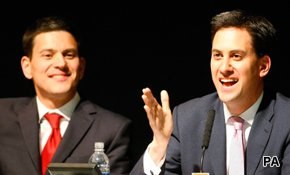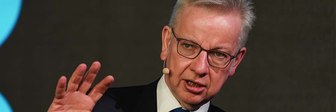The first scientific survey of the whole of Labour’s electoral college tells us that the name of the next Labour leader will be Miliband, but not for certain which brother will win the prize. David Miliband leads his brother, by 37-29% on the first count, and 54-46% in the run-off between them. (The other candidates are nowhere.)
So David currently holds an eight point lead over Ed in both rounds. The other three candidates trail miles behind. But with five weeks to go before ballot papers are sent out, four big uncertainties remain.
Main uncertainties
The first is whether the leaders of the big unions have much influence on their members. The big three – Unison, Unite and GMB – comprise more than three-quarters of all union members with a vote in the leadership election, and are all officially backing Ed. But our poll shows that their members currently prefer David (Unison, GMB) or are evenly divided (Unite). Strong union campaigns for the younger Miliband could close the gap between the brothers.
Second, will differential turnout affect who wins? If the supporters of one Miliband prove to be more determined than the other to support their preferred candidate, the result could be different. This is especially true in the trade union section, where turnout is likely to be lower than among party members or MPs. Our voting figures are based on roughly one third of the membership of the unions that are affiliated to the Labour Party. We have excluded the 60% who say they are not Labour Party supporters; among the remaining 40% the voting figures we have excluded the 18% who express no preference for any of the candidates.
Third, according to the blog Left Foot Forward, which has supplied our data for MPs and MEPs, at least 80 parliamentarians - ten per cent of the whole electoral college - currently back the outsiders: Diana Abbott, Ed Balls and Andy Burnham. Once these three have been eliminated, which Miliband will they back? Few are saying; so we are assuming that they divide evenly between Ed and David. But if one of the brothers manages to scoop the lion’s share of these MPs’ second preferences, their votes could be decisive.
Fourth, the final result will be influenced by second, and sometimes third and fourth, preferences of party and trade union members. Neither Miliband comes anywhere near the 50% winning post among first preferences. In our survey we asked people which Miliband people prefer. If we take those party members whose first choice is Diane Abbott, Ed Balls or Andy Burnham, we find that 51% back Ed and 33% back David. But when we divide these respondents into who say they ‘definitely’ prefer one of the brothers and those who say merely that they ‘probably’ prefer one of them, we find that the ‘probably’s outnumber the ‘definitely’s. This means that these lower-preference decisions could change. (Incidentally, among trade unionists, David currently attracts slightly more second preferences than Ed.)
If David does retain his overall lead, it will be because Labour members and trade unionists these days are different from the way they were in the Eighties. Most think he is NOT on the Left – or that his views are similar to theirs – but the DO regard him as a winner; and today’s party members are more interested in electability than ideology. How different from the days of Michael Foot and the Tony Benn insurgency.
Methodology
The boring but important bit: between July 27th and 29th we polled 1,184 Labour Party members and 1,102 Labour-supporting members of trade unions affiliated to the Labour Party. These figures include 300 people who are both party members AND members of affiliated unions; we count them in both groups, as they will have two votes in the leadership election. In all we polled 2,609 members of affiliated trade unions, but we have excluded those – the majority – who are not Labour supporters.
We weighted the raw data to our estimates of the age, gender and social class of party members and the members of trade unions affiliated to the Labour Party. We derived these estimates from a nationwide survey of more than 100,000 adults earlier in July. In addition, we weighted the trade union data to the most recent published figures for the overall membership of each affiliated trade union. In practice, the raw and weighted figures for each candidate are virtually identical.
Party members and trade unionists comprise two thirds of Labour’s electoral college. The final third comprises 271 Labour MPs (258) and MEPs (13). Our figures for this section come from Left Foot Forward, an independent but broadly pro-Labour blog. They have data on 257 of the 271 MPs/MEPs.









